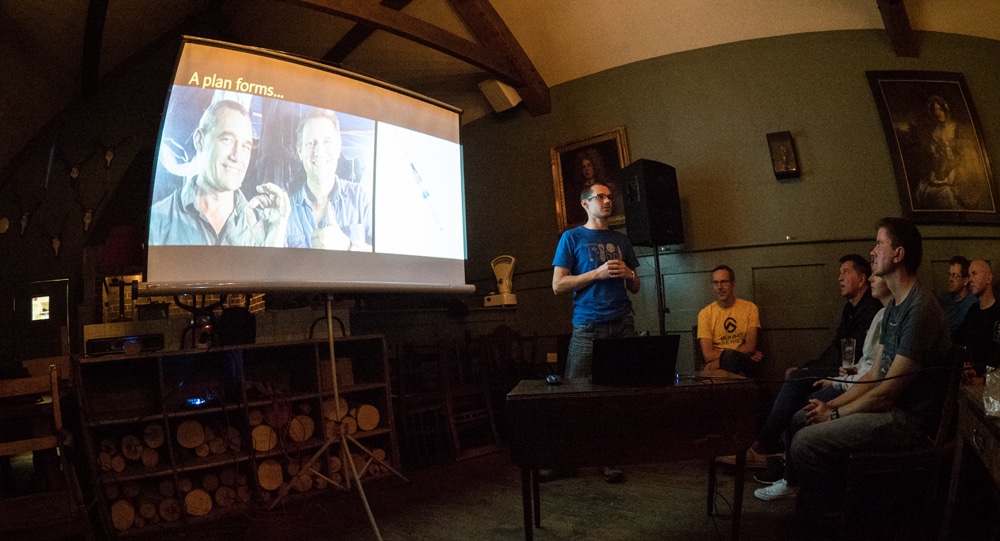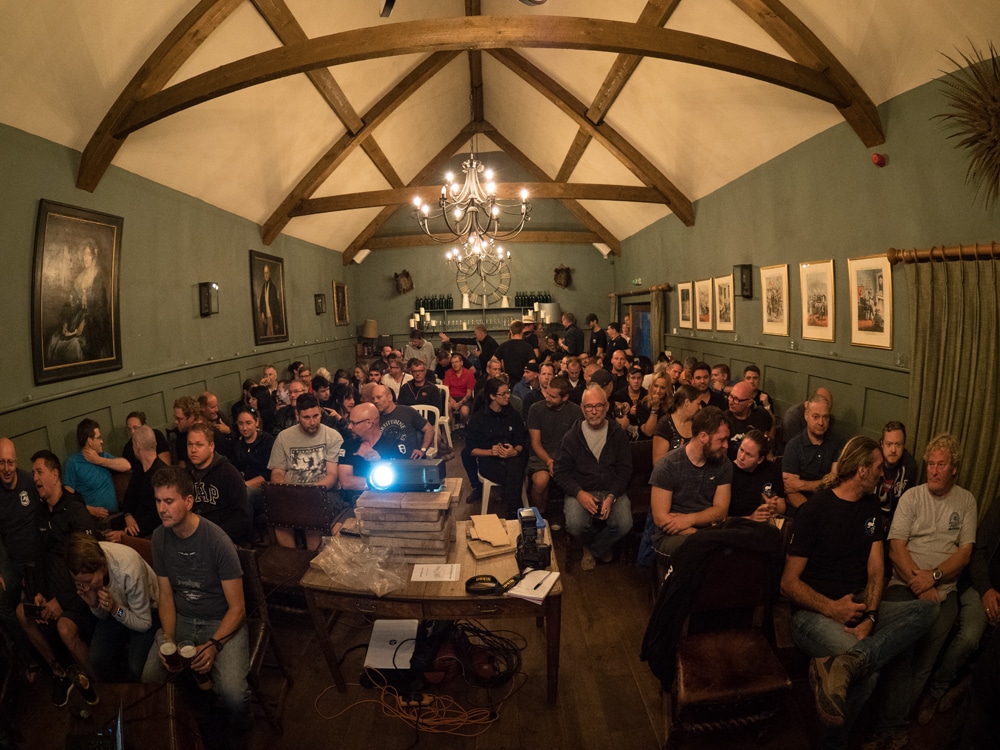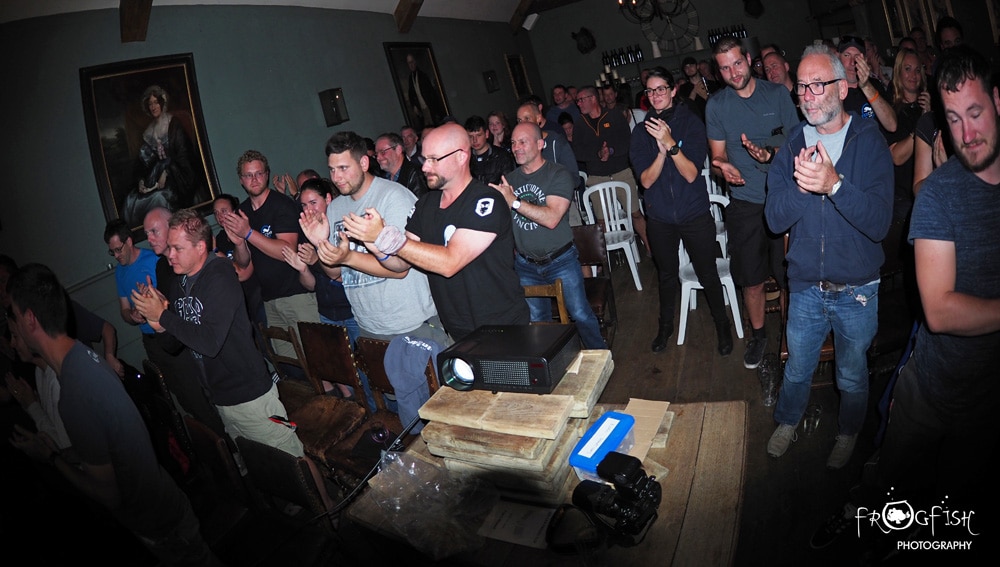News
Thailand Cave Rescue

 Tham Luang Cave Rescue Talk at TekCamp 2018 Speakers: John Volanthen & Chris Jewell
Tham Luang Cave Rescue Talk at TekCamp 2018 Speakers: John Volanthen & Chris Jewell
There was a real buzz in the packed room in The Talbot Inn in Mells, Somerset, where divers gathered at the end of the first day of TekCamp 2018 to hear about the story that gripped the world earlier in the summer.
The room was packed, with standing room only as John and Chris took the stage. They were introduced by Tim Clements from Vobster Quay / TekCamp. We could not wait to hear, straight from the horse’s mouth, what had actually happened in those weeks in June and July when divers strove to rescue the young Thai football team and their coach.
John Volanthen started the talk, giving those attending a real feel for the task that lay ahead of the rescue team. The boys and their coach had ventured into the cave on a bright sunny day, with no indication of what might lie ahead of them. In fact, it was heavy rain the night before, that took 12 hours to seep through the hills and into the cave system, that was the cause a rapidly rising water cutting them off. As concern grew, so did the numbers in the rescue effort at the mouth of the cave system, but it was Vernon Unsworth, who lives in Thailand and was expecting to dive the cave system that very week, who saw the need to a specialist cave diving team to get there as soon as possible. John was one of the first to fly out, on the 26th July, along with Rick Stanton, and the two of them got straight off the plane and into the cave to check out the situation that faced them.
The water column kept on rising, at a rate that was visible to the naked eye. Something drastic was happening. More rain was falling, and this was torrential monsoon rain that brings huge amounts of water to the area in a short space of time. John described the dives as being something like “white water caving” such was the current they had to make progress against. Soon, the dry chambers at the mouth of the cave entrance were filling up too. But the rain did stop, and pumps worked day and night to try to bring down the water level in the various cave chambers.
The Thai Navy, who comprised experienced divers, but none with cave diving experience, took hundreds of cylinders to chamber 3. The US Para-Rescue team arrived and started co-ordinating the various rescue teams on the ground. The diving started up again, and the UK team decided that as there were lots of available cylinders and the cave system was shallow, they would use simple open-circuit dive gear for their search and rescue dives. After two more days of laying lines and progressing further into the caves, John and Rick surfaced in an air bell. Rick, who is “built for smelling”, detected a scent and as they looked around they suddenly saw people moving around and were overwhelmed when they confirmed that they had all 13 alive standing in front of them. “There is no training course that can prepare you for this!” They handed out spare lights and John promised they would come back for them. At Chamber 3, they handed video footage of the survivors to the Thai team, and before they got out of the cave system, the whole world knew what they had found!
It is at this point that Chris took over the talk, as it was this point in the story that he was called, whilst giving an early morning tv interview, to ask him to come out to Thailand ASAP and to bring over 300kg of kit with him. Just after Chris arrived, the tragic death of Thai Navy Seal, Saman Kunan, was announced. The UK divers were not on site at the time and did not know what happened. On Chris’ first full day in the region, he, along with Jason Mallinson, did a supply run to the kids, giving them a chance to experience for themselves the challenge ahead, along with taking the much-needed food rations to the survivors. That evening, a team of 3 UK surface controllers arrived, to help with the planning and co-ordination of the rescue. A plan was starting to form, and it involved full sedation using Ketamine, positive pressure full face masks and pure oxygen.
Before the rescue began, the boys (and their families) were told about the plan and agreed to it. The four British Divers would dive a boy each through the cave system, with an Australian anaesthetist giving the initial injection. At each point in the cave system where the divers would surface, more diving and medical specialists would be on hand to assist, but the underwater sections would be done as one cave diver with one boy. Diving unconscious kids through a cave system had never been done before, the risks were great, but there were no alternative options. “We knew it was a high risk rescue with a high probability of fatalities”.
The distance from Chamber 3 to the area where the boys were located was around 1.5km, with sections that were either fully,or part submerged. The kids themselves decided who got to go first, and so “the ones with the furthest cycle home” were the first to be rescued! The four UK divers: John Volanthen, Chris Jewell, Rick Stanton and Jason Mallinson began their rescue attempt with 3 cylinders for themselves, plus an O2 cylinder for the boy they would be rescuing. They ditched one of their tanks at the turning point, the kids would get themselves into their wetsuits, be sedated, and then carrying them facedown, they began their long journey back to Chamber 3. Once at Chamber 3, a medical team and the Thai Navy were there to rush them to the cave entrance and onto hospital.
The first day saw 4 boys being rescued to huge praise from everyone on site, and around the globe, but the team had to do it two more times. “We really didn’t believe we would have total success”.
John takes back the chair and continues the story at this point in proceedings. The final day dawned and they had 4 more boys and the coach to get back to safety. The rain had started, and it felt like “luck was on a razor edge”. The Americans had smuggled in KFC and Jack Daniels into Chamber 3 to celebrate with the dive team as they finished their amazing rescue. John reflected that their success was down to everyone there: military, cave divers and even the politicians who took hard decisions. “They trusted us and we didn’t let them down”.
This was without doubt the most incredible talk on diving we have ever been too. Well done to the TekCamp 2018 team for arranging it, and a huge thank you to John and Chris for their honest talk about an event that gripped the world for nearly 3 weeks. To get such a detailed insight into this rescue was amazing. The bravery shown by these two divers and all those that took part in this rescue is admirable and the fact that they were so humble in describing events made them seem even more like modern day super heroes that they clearly are.
For more on TekCamp visit the website by clicking here.
Gear News
Introducing the TR-80, IR-50 and CS-30 Regulators from DYNAMICNORD

Whether you are a beginner or a professional diver – with the three new main regulators from DYNAMICNORD, everyone will find their favourite regulator. They all look super stylish.
Excellent performance with the TR-80
Quality and performance are the be-all and end-all for regulators. It is not for nothing that the TR stands for Tec Reg. The innovative design of the TR-80 guarantees absolute reliability – even in ice-cold waters.

Perfect breathing effort at 0.8 J/l / certified for diving in waters below 10 degrees / structural design made of solid brass for best cold protection / membrane-compensated design with dry seal of the first stage / reduced exhalation effort thanks to optimized exhalation membrane and bubble deflector / adjustable Venturi (dive/predive) and adjustment knob for individual inhalation comfort / innovative design of the front cover prevents free-flow in strong currents or when diving with scooters / design made of sandblasted brass, matt chrome finish / 2 HP and 4 LP outlets / mouthpiece made of high-quality, anti-allergic silicone for maximum comfort.


Amazing underwater adventures with the IR-50
The IR-50 is the top regulator for advanced and experienced divers. Natural breathing is the essence of this regulator.

Ideal breathing effort at 0.8 J/l /certified for diving in waters below 10 degrees / compensated membrane / adjustable venturi (dive/predive) and adjustment knob for individual inhalation comfort/ outlet valve and deflector for minimum exhalation effort and reduction of bubbles on the face / design made of sandblasted brass, matt chrome finish / 2 HP and 4 NP outlets / mouthpiece made of high-quality, anti-allergic silicone for maximum comfort.


The Workhorse – our CS-30
For diving centres and diving beginners – the workhorse stands for strong construction, reliability and robustness. Perfect for your training.

Optimal breathing effort at 0.8 J/l /recommended for diving in waters above 10 degrees / non-compensated piston / adjustable venturi (dive/predive) / outlet valve and deflector for minimum exhalation effort and reduction of bubbles on the face / design made of sandblasted brass, matt chrome finish / 1 HP and 3 NP outlets / mouthpiece made of high-quality, anti-allergic silicone for maximum comfort.


Octopus OP-30
The OP-30 is the ideal addition to all DYNAMICNORD regulators. It is identical in construction to the CS-30.

The TR-80, IR-50, CS-30 (DIN & INT) regulators and the Octopus OP-30 are available from DYNAMICNORD dealers and in the online store.
DYNAMICNORD – Your Outdoor Companion.
Marine Life & Conservation
Paul Watson Released as Denmark Blocks Japan’s Extradition Bid

Renowned anti-whaling activist Paul Watson has been released from custody in Greenland after spending five months in detention. Denmark’s Justice Ministry rejected Japan’s request for his extradition, citing insufficient guarantees that his time already served in custody would be credited against any potential sentence.
The 74-year-old Canadian-American was arrested on July 21 in Nuuk, Greenland’s capital, when his ship docked to refuel. His arrest was based on a 2012 Japanese warrant related to a 2010 encounter in Antarctic waters. Japan alleged Watson obstructed operations and caused damage to a whaling research ship during efforts to disrupt illegal whaling. Watson has consistently denied these claims, maintaining his commitment to marine conservation.
Denmark, which oversees extradition matters for Greenland, concluded that while the legal conditions for extradition were met, the lack of assurances from Japan regarding time-served credit made extradition untenable.
In a video shared by his foundation, Watson expressed gratitude and relief, saying, “After five months, it’s good to be out… and good to know they’re not sending me to Japan.” He added that the most difficult part of his time in custody was being separated from his two young sons.
Watson is a pioneering figure in marine conservation, known for founding the Captain Paul Watson Foundation in 2022 after decades of activism with the Sea Shepherd Conservation Society. His bold efforts to defend marine life have earned him widespread support, including from celebrities and conservationists. His work has also been featured in the acclaimed reality TV series Whale Wars.
Watson’s lawyer, Jonas Christoffersen, praised the decision, stating, “We are happy and relieved that Paul Watson is now free.” He added that Watson is eager to reunite with his family and continue his vital work.
The arrest occurred while Watson’s vessel, the M/Y John Paul DeJoria, was en route to the North Pacific with a team of 26 volunteers to intercept a Japanese whaling ship. His foundation described the arrest as politically motivated and emphasized that Watson’s actions were focused on ending illegal whaling practices.
Japan resumed commercial whaling in 2019 after leaving the International Whaling Commission, asserting that whale meat is a cultural tradition. Conservationists, however, continue to challenge these practices, highlighting their impact on marine ecosystems.
Despite the challenges, Watson remains steadfast in his mission to protect marine life and bring attention to whaling practices. His dedication to ocean conservation has made him a globally respected advocate for the environment.
-

 News2 months ago
News2 months agoIconic SS United States to become the World’s Largest Artificial Reef
-

 News3 months ago
News3 months agoBook Review – 52 Assignments: Underwater Photography
-

 Gear News3 months ago
Gear News3 months agoDYNAMICNORD – New German diving brand enters the British market
-

 News3 months ago
News3 months agoExploring Cenote El Pit: A Diver’s Dream
-

 Gear News3 months ago
Gear News3 months agoTry BARE drysuits (and maybe even win one!) this Friday with Sea & Sea at North West Dive Fest
-

 Marine Life & Conservation3 months ago
Marine Life & Conservation3 months agoBook Review: Coral Triangle Cameos
-

 Blogs2 months ago
Blogs2 months agoDive the Egyptian Red Sea this Autumn with Regaldive
-

 News3 months ago
News3 months ago2024 Ocean Art Underwater Photo Competition Announced




















